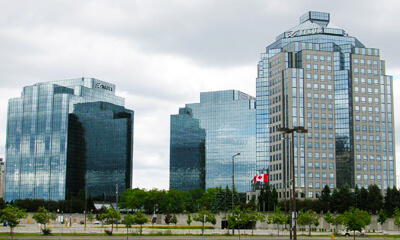Precedent-Setting Verdict Should Reduce Bird Collision Deaths in Canada
 |
| Consilium Place by FLAP |
(Washington, D.C., February 19, 2013) A significant legal precedent was set last week in Canada that could have ripple effects worldwide. A Canadian judge has recognized in a ruling the need for building owners to take action to reduce migratory bird deaths from lethal collisions with the highly reflective windows of office buildings.
“This is a significant development in an increasingly serious issue that is gaining more attention worldwide – the impact of man-made structures on wildlife, especially birds, and the need to modify existing buildings, as well as incorporating bird-friendly design into new construction,” said Dr. Christine Sheppard, Bird Collisions Campaign Manager for American Bird Conservancy, one of the leading U.S. bird conservation organizations and the only one in the U.S. with a national bird collisions program.
Cadillac Fairview, one of Canada's largest commercial property owners and managers, was charged with violating the Environmental Protection Act (EPA) and the federal Species at Risk Act (SARA). In a ruling, Judge Melvyn Green of the Ontario Court of Justice found that hundreds of birds, including threatened species, had been injured and killed at the company's Yonge Corporate Centre, consisting of three office buildings in Toronto, during the 2010 spring and fall migrations. Judge Green ruled that both the EPA and SARA are properly interpreted to prohibit the emission (intentional or unintentional) of reflected light where that reflection causes the death or injury of birds.
While the Toronto court acquitted Cadillac Fairview and related companies of the charges, that verdict was handed down only as a consequence to the corporate steps being taken to address the problem. The company began investigating window films as a solution after Ecojustice and Ontario Nature laid similar charges against a different building owner, and subsequently installed window films on the most lethal side of their complex at a cost of over $100,000. The company also committed to retrofitting the remainder of the complex.
“The law is now clear that owners and managers of buildings with reflective windows that kill or injure birds must take action. This is a major success, even if it's not a complete victory,”said Ecojustice lawyer Albert Koehl, one of the case prosecutors.
The court found that light reflected from the Yonge Corporate Centre's glass windows was responsible for luring the birds to their injury or death. Migratory birds are confused by the illusion of safe havens like sky and trees reflected in windows. Buildings with highly reflective windows, like those found at the Yonge Corporate Centre, are especially dangerous for birds, although non-mirrored glass can also produce dangerous reflections.
Judge Green rejected Cadillac Fairview's argument that the law does not apply to protect migratory birds from reflected light. He concluded, however, that the company was on the way to addressing the problem and acted reasonably in the circumstances.
“The judge's ruling also means that the Ontario Ministry of Environment will now be obliged to regulate buildings whose reflective windows are killing birds,” said Koehl.
The ruling marks the first time that the EPA and SARA have been found by a court to apply in the case of window strikes that kill birds.
“Ecojustice, Ontario Nature, FLAP and the City of Toronto are to be congratulated. Their efforts already have saved the lives of scores of birds and it appears the effects could be of huge benefit long term,” Sheppard said.
The issue of bird collisions with buildings exists in all countries. In the U.S., estimates say as many as one billion birds are killed in such collisions each year. But interest in preventative measures has also been gaining momentum in the U.S. in recent years. The City of San Francisco passed Standards for Bird Safe Buildings; several municipalities around Chicago have taken legislative action, the State of Minnesota is poised to add requirements for bird-friendly design to their sustainability program, and more actions are in process.
In response to the interest in the issue in the U.S., ABC published Dr. Sheppard's Bird-Friendly Building Design, available for download at collisions.abcbirds.org. The publication provides a comprehensive review of the collisions issue and the science behind the problem and its solutions, including many examples of beautiful bird-friendly buildings that also work well for people living in and using them.
ABC has also led the team that created LEED Pilot Credit #55, which allows building owners, architects, designers and developers pursuing LEED (Leadership in Environment and Energy Design) green building certification to earn credit for incorporating design strategies that reduce bird collisions. Glass and window film manufacturers have taken notice and are starting to promote existing bird-friendly products and to develop new ones.
Window films with markers are only necessary on the lower floors of buildings, where birds face the greatest danger. The City of Toronto has recommended the use of window markers since 2007.
The Fatal Light Awareness Program, an environmental group that works to protect migratory birds in the urban environment, estimates that collisions with the city's buildings kill one million birds each year. All buildings constructed after 2010 in the city of Toronto, are required to include measures to reduce bird strikes. The trial began in April, 2012.


















































